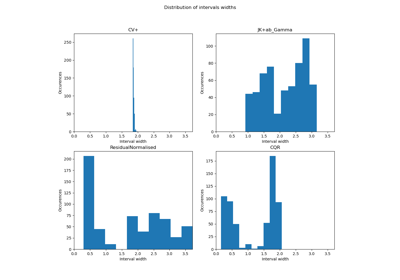mapie.metrics.regression_ssc¶
- mapie.metrics.regression_ssc(y_true: numpy.ndarray[Any, numpy.dtype[numpy._typing._array_like._ScalarType_co]], y_intervals: numpy.ndarray[Any, numpy.dtype[numpy._typing._array_like._ScalarType_co]], num_bins: int = 3) numpy.ndarray[Any, numpy.dtype[numpy._typing._array_like._ScalarType_co]][source]¶
Compute Size-Stratified Coverage metrics proposed in [3] that is the conditional coverage conditioned by the size of the intervals. The intervals are ranked by their size (ascending) and then divided into num_bins groups: one value of coverage by groups is computed.
Warning: This metric should be used only with non constant intervals (intervals of different sizes), with constant intervals the result may be misinterpreted.
[3] Angelopoulos, A. N., & Bates, S. (2021). A gentle introduction to conformal prediction and distribution-free uncertainty quantification. arXiv preprint arXiv:2107.07511.
- Parameters
- y_true: NDArray of shape (n_samples,)
True labels.
- y_intervals: NDArray of shape (n_samples, 2, n_alpha) or (n_samples, 2)
Prediction intervals given by booleans of labels.
- num_bins: int n
Number of groups. Should be less than the number of different interval widths.
- Returns
- NDArray of shape (n_alpha, num_bins)
Examples
>>> from mapie.metrics import regression_ssc >>> import numpy as np >>> y_true = np.array([5, 7.5, 9.5]) >>> y_intervals = np.array([ ... [4, 6], ... [6.0, 9.0], ... [9, 10.0] ... ]) >>> print(regression_ssc(y_true, y_intervals, num_bins=2)) [[1. 1.]]
